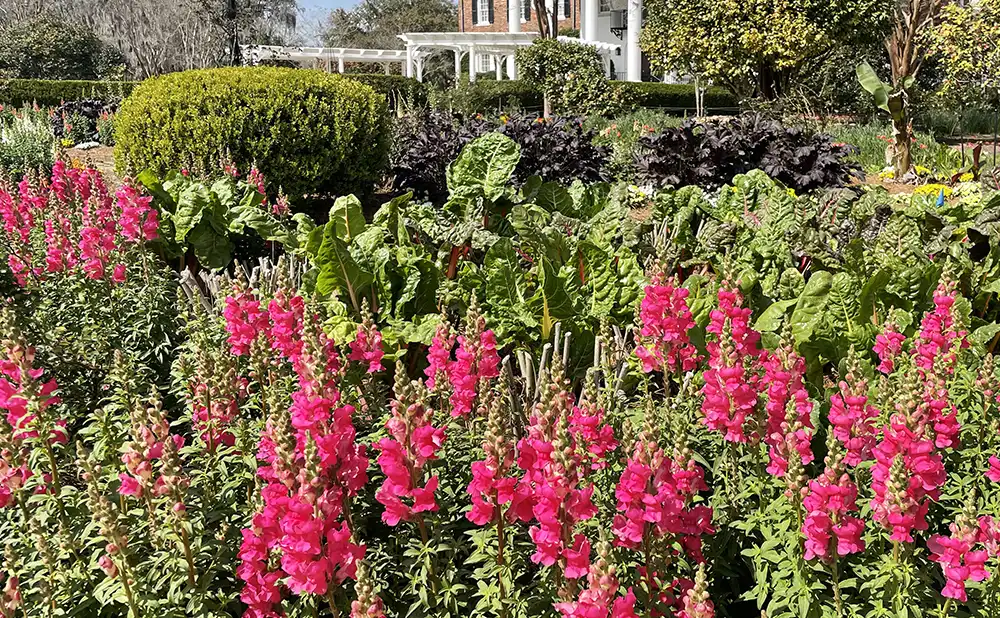
Spring has arrived again, and throughout the Lowcountry the landscape is transforming all around us. Dedicated gardeners have returned to their modest flower beds while full-time horticulturists prepare their tools to create magnificent floral and arboreal masterpieces for all to see. Many of the area’s prominent plantations and historic sites boast some of the most amazing gardens in the South, and they’re ready to welcome tourists — or staycationers just like you.
To our north, Brookgreen Gardens decorates the landscape at Murrells Inlet. Among the best-loved features of this sprawling former rice plantation is Live Oak Allee, whose stately trees draped with Spanish moss and resurrection ferns date to the early 1700s. The Butterfly House offers another highlight. The specially selected flowers and shrubs give shelter and sustenance to the butterflies, who return the favor by providing the entertainment with their multi-hued airborne ballet. Brookgreen also offers the Palmetto Garden, named for South Carolina’s state tree the sabal palmetto, and the Dorothy P. Peace Garden Room for Children. The notable Brenda W. Rosen Carolina Terrace Garden is a crowd-pleaser with its myriad perennials, roses, shrubs and mature trees. The Fountain of the Muses is a great stop to view carefully curated sculptures fashioned from bold gardening designs.
According to Miles Arnott, Brookgreen’s vice president of horticulture and conservation, the most fielded question from callers is “When are the azaleas in bloom?” The answer: right now. He said that “Indica and Formosa azaleas are blooming right now, with a variety of South Carolina native azaleas coming into bloom a little later in the spring — just as our hundreds of dogwood trees blow sprinkling flashes of white amid the azaleas’ purples.”
Closer to home, situated in the heart of East Cooper at Long Point Road and US 17, is Boone Hall Plantation and Gardens. Entered through its own grand three-quarter mile-long “Avenue of Oaks,” Boone Hall offers a wide range of trees throughout the property, including peach and pecan. During spring, many are draped in sweet-smelling wisteria as well. Known best to some for its spectacular special events, Boone Hall also features a host of different gardens and a wide variety of native plantings. A highlight of any garden visit to Boone Hall includes a saunter through its antique roses. Another “don’t miss” is its extensive Butterfly Pavilion, where guests can enjoy these colorful creatures while learning about the stages of their life cycles.
According to director of horticulture Katie Dickson, “Our gardens are a year-round point of interest; 365 days a year they delight and entertain our guests with an array of flowers that really draw them into the landscape.”
Although the plantation itself dates its founding to 1681, Dickson explained that its lush gardens began adorning the front of the mansion home less than 100 years ago. “While they are a fairly young feature, they really do augment the property and serve as a beautiful ornament. Plus, they are functional,” she added, “supporting an array of pollinators including our honeybees, which live in dozens of hives around the property.”
In addition to the profusion of perennials, annuals, herbs and antique roses — all of which overwhelm the senses, the plantation will offer a new floral attraction this year surrounding its newly restored cotton gin complex. “We are putting in a landscape of hundreds of native species including historically significant antique roses. We’re delighted that these perimeter plantings will be not only visually striking, but low-maintenance and suited to our climate and ecology. That’s really the icing on the cake,” said Dixon.
Across the Cooper River, on the banks of the Ashley River, is another garden-centric site — and a perfect day trip for locals —Magnolia Plantation and Gardens. Acknowledged as one of America’s most beautiful gardens, the plantation boasts the nation’s last large-scale romantic-style garden. According to head horticulturist Jim Martin, “Unlike formal gardens in countries such as England and France, which are laid out in man-controlled designs, our gardens are meant for strolling, tranquility and imagination. Soon, we will have azaleas and camellias in full bloom — and the whole plantation will be ablaze in color.”
While Magnolia Plantation — with its gardens and mature stands of live oaks and bald cypress trees — evokes the feel of the grand gardens of the 19th century, the beauty of this place is that other portions of its acreage are devoted to cultivating today’s flora.
“We do our best to also focus on things that are new and exciting,” Martin added, “including things people could do in their own gardens even without the land, facilities and staffing needed here.”
It seems that wherever one turns, the beauty of flowers and trees abounds in the Lowcountry’s grand public gardens. Of course, that doesn’t even begin to count the unique floral accomplishments of thousands of dedicated amateur gardeners up and down our coast. The public gardens have clearly served as role models for the entire landscape of coastal South Carolina. Perhaps this season you will stroll through and become inspired by what is possible when man nurtures nature.
By Bill Farley
Leave a Reply